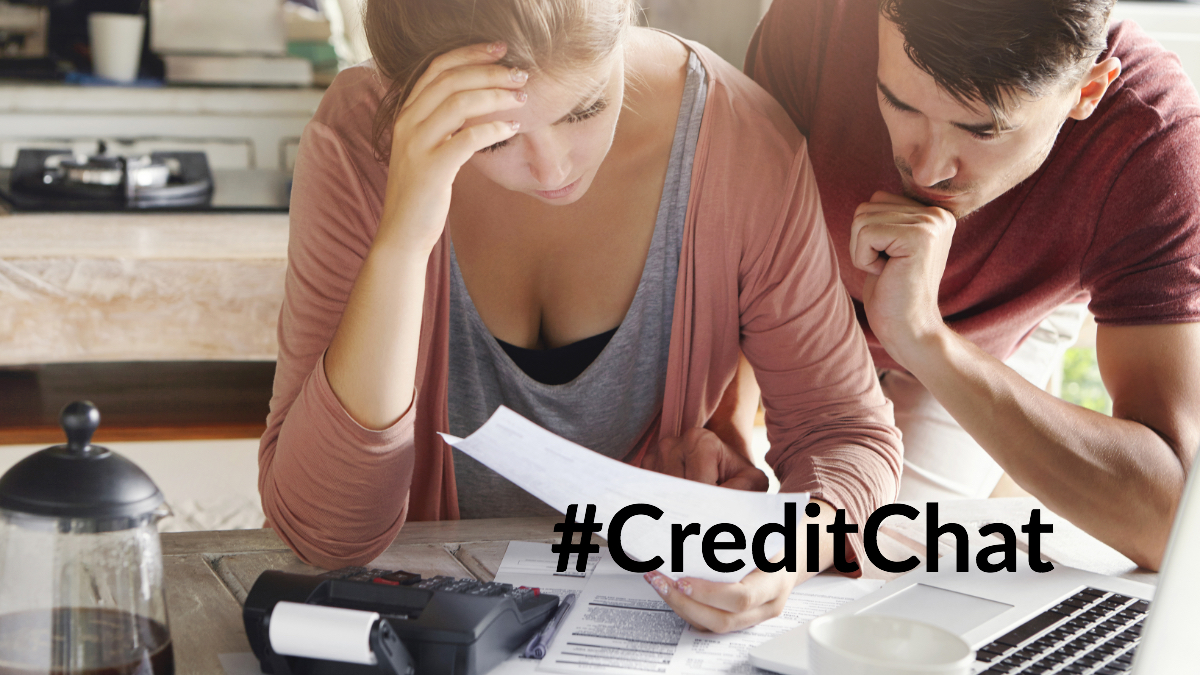Ways to Minimize Your Debt This Year
Join our #CreditChat on Twitter on Wednesday, January 16, at 3 p.m ET. This week, we’re talking about ways to minimize your debt this year.
Topic: Ways to Minimize Your Debt This Year
When: January 16, 2019, at 3 p.m. ET.
Easy ways to chat with us on Twitter: Tchat
The panel will include: Rod Griffin: Director of Public Education at Experian; Howard S. Dvorkin: serial entrepreneur, author, personal finance expert and Chairman of Debt.com; Leslie H. Tayne, Esq: Founder and Managing Director of Tayne Law Group, P.C. (f/k/a The Law Offices of Leslie H. Tayne, P.C.); Vicki Cook, Ed.D.: Co-founder WomenWhoMoney.com, Founder Make Smarter Decisions; Scott Sherman: Owner of personal finance blog I Dream of FIRE; Deanna Broaddus: owner of financial independence blog Ms. Fiology.
Questions We’ll Discuss:
- Q1: What resources or apps are available to those trying to pay down debt?
- Q2: Is a credit card balance transfer worth it?
- Q3: What should you do if your balance transfer limit is too low?
- Q4: What are some common myths that keep people in debt?
- Q5: How does debt affect your credit score?
- Q6: At what point should you file for bankruptcy?
- Q7: In what order should I pay off my debts?
- Q8: Should I prioritize paying off debt or saving for emergencies?
- Q9: What are some best practices for avoiding credit card debt altogether?
- Q10: Any final tips on minimizing debt?
Ways to minimize your debt this year
By Patricia Guevarra
The number one new year’s resolution Americans make is to save money. Whether it’s for your retirement, an emergency fund or future travel, saving money takes a lot of thought and effort, which is where so many people go wrong. Being fiscally responsible involves a lot of budgeting, planning and discipline, and if you’re in debt, it can be incredibly difficult — and feel impossible — to save extra cash.
It’s hard to look at the new year as a clean slate when you’re struggling with debt. I know the pain; there were days when I looked at my credit card balances and my bills and felt like I would never be able to save for anything. There are still days when I feel desperate to be debt-free, but I finally have a plan that will help me pay off my consumer debt before the end of the year. Having debt is hard enough, and it’s harder when you feel helpless about it.
Saving money is a respectable and admirable goal. If you want to achieve that goal this year, focus on minimizing your debt so you can finally use your hard-earned money on the things you really want to spend it on. We are leaving our helplessness in 2018! Here are a few ways we can start:
Prioritize your debt
When you get paid, you should immediately subtract the money you need to pay your credit cards, set it aside and consider it money you can’t spend. Better yet, set automatic payments for your credit cards. If you can, pay more than the minimum required each month. That could mean making multiple payments a month or cutting spending elsewhere. This is where a little sacrifice is required. Sometimes I had to cut spending on things that weren’t absolutely necessary for weeks at a time so I could keep paying more than required. This isn’t sustainable for long periods — you still need to have fun! — but try to evaluate your spending and make sure you’re putting your debt first. And if you come by extra money, whether from a pay bump, a bonus, a side hustle or something else, make it a habit to pretend you never had it in the first place. Set that money aside to pay your debt instead of spending more because you have more.
Consider a balance transfer
After a few months of consistently paying much more than the minimum amount, I noticed that one of my card balances wasn’t going down. I wasn’t using the card for any purchases, so I was more than a little confused. My mom had opened a card for me when I turned 18 and I didn’t know much about it, but when I reviewed the statement, I was horrified to learn that the APR was 31 percent. I was even more dismayed when I realized the payments I had been making were just enough to cover the accumulating interest. Fun fact: According to that same statement, it would’ve taken me 42 years to repay that entire debt at the rate I was paying. That’s when I went into research overdrive and found out about balance transfers, which allow you to take your balances (up to a certain amount) from other cards and move them to a new or existing card, almost always with zero interest for the first year or so.
Using a balance transfer was the ultimate game changer for me. Consolidating my debt from four different cards to one made my repayment struggle a lot easier and lifted a lot of my anxiety. The card I chose allowed a maximum transfer of $15,000 with zero interest for the first 15 months and an APR of 13 percent to 24 percent, depending on my score after that. Being able to pay your debt without accruing interest really helps, but there are a few things to consider. Opening a new credit card might hurt your score, especially if your credit age is still young. Your credit age is a big factor in determining your score, and opening a new credit card will lower your average age.
Do your research to figure out if a balance transfer is a good fit for you. If you decide that it is, remember: Don’t close your existing cards after transferring your balances. Closing your existing cards will hurt your credit age, as well as your credit utilization ratio. It’s important to understand that a balance transfer isn’t the end of your issues. It’s just a way to assist with them. Don’t transfer your balances just to start using your old credit cards again and accumulating even more debt. Do the math and develop a solid plan to repay your debt while that zero percent interest rate lasts.
Strategize your repayment
Again, balance transfers aren’t for everybody. If you decide against one, there are a multitude of ways for you to repay your debt at a feasible rate. Two of the most popular methods are the debt avalanche and the debt snowball. The avalanche method requires paying off debts with the largest interest rate more aggressively than your other debt to save money by avoiding any further accumulation of interest. This is the way to go if you’re a math person looking to maximize your savings as you pay. The snowball method celebrates your small victories and prioritizes repaying your smallest debts first. It’s a more psychological approach that benefits people who need a bit of inspiration during their repayment journey. Some people find it motivational to watch their balances — however small — come down to zero. But whichever repayment strategy you choose, you should make minimum payments on all your accounts, then make the bigger payments to the accounts suggested by your chosen method.
Understand your habits
Now that you have a repayment plan in place, it’s time to understand what got you here in the first place. The debt that put me into a hole was the result of a lot of things: an internship that didn’t pay a living wage, the unwise decision to use my credit cards for my bills and all my recreational activities, the unwillingness to forego recreational activities, the failure to save any money at all over the span of a year and a half, and, lastly, my debt shame, which prevented me from asking for advice or help until I was already in too deep.
It took a lot of lifestyle changes and self-reflection for me to understand that I was the only reason this happened. I used to blame my internship for my debt because it was the easiest way to explain away one of my biggest struggles. But the reality is that even though I didn’t have a living wage, I could have left that gig with less than half the debt I actually had. I was spending recklessly and telling myself, “It’s OK. I’ll pay it later.” Thousands and thousands of dollars in, it was suddenly “later,” and I had no idea how I was going to repay my debt.
To make sure you never get into an overwhelming amount of debt again, it’s important to understand what happened and who you are as a spender, a saver and an earner. It’s easy to get through a hardship and promise yourself it won’t happen again, but unless you can check yourself and hold yourself accountable, you’re vulnerable to another occurrence. Get to know what triggers your spending, what methods work best when it comes to saving and the ways you can earn the most money you can, and you’ll have the best chance at ensuring that you’re more fiscally responsible in the future.
Know your warning signs
If you start slipping, know your warning signs. In retrospect, my warning signs were flashing in bright red. Relying heavily on my credit cards to pay for necessities like rent or utilities, holding off paying one card so I could pay another and trying not to check my credit card balances if I could help it — these were all significant signs that might have helped me face reality if I’d been responsible enough to acknowledge them. It’s better to recognize that you might need help before you’re in too much trouble to even begin comprehending how to fix the situation.
—
Credit cards are valuable tools, but things can go awry quickly if you aren’t mindful about your habits. Find out even more ways you can work to minimize your debt in the new year at our #CreditChat on Periscope, YouTube Live, and Twitter every Wednesday at noon Pacific time, 3 p.m. Eastern time.

